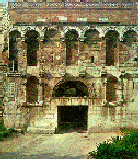 | ||
The exposition in the Catherine Palace Museum (prior to 1910 - the Great Tzarskoje Selo Palace) encompasses the 250-year history of the famous monument, and acquaints visitors with the work of the architects who participated in its construction and decoration in the 18th and 19th centuries, and also with the current state of this unique landmark, with the work of restorers who managed to bring the palace back to life after World War II. Currently, 29 of the 57 palace halls destroyed during the war have been restored.
In 1717, when the city of St. Petersburg was just being built on the banks of the Neva river, Tzarskoje Selo saw the construction of a new, stone imperial manor, which became known as the "Stone Chambers" of Catherine I. In August of 1724, when the construction was already completed, a celebration was organized in the palace during which "13 cannons were fired thrice." The Tsar and all of the major government dignitaries were present.
The palace was a small two-story building typical of Russian palaces of the early 18th century. The first attempt to expand the palace was undertaken during the reign of Empress Elizabeth according to plans by Mikhail Zemtsov at the end of 1742 and beginning of 1743. Reconstruction of the Catherine Palace and park ensemble was carried out by his pupils, Andrei Kvasov and Savva Chevakinsky. Following the death of Mikhail Zemtsov, work at Tzarskoje Selo passed under the direction of Andrei Kvasov and his assistant, the builder Giuseppe Trezini. On May 5, 1745, along with Trezini, Savva Chevakinsky was appointed to Tzarskoje Selo, and the latter oversaw the construction at Tzarskoje Selo until 1760. From the end of 1748 and through 1756, construction of the Tzarskoje Selo residence was directed by court architect Bartolomeo Francesco Rastrelli. On May 10, 1752, Empress Elizabeth signed a decree ordering the complete overhaul of the old palace. On July 30, 1756, Bartolomeo Francesco Rastrelli presented his creation to Elizabeth and foreign diplomats.
The palace was quite impressive with its size, powerful spatial dynamics and picturesque decoration in the style of the Russian Baroque. The wide, light blue ribbon of the palace with its snow-white columns and gilt ornament looked quite festive. The northern wing was topped by the five golden domes of the Palace Chapel, and the southern wing, which contained the formal, state rooms, was topped off by a golden dome with a star on the spire. Approximately 100 kilograms of gold were used to gild the exterior and interior ornaments. At this time the formal yard was also designed, surrounded by the palace's service buildings placed in a semi-circle around the "circumference" of the yard. The galleries of the palace's facade consisted of windows and columns, each of which bore a wooden, gold-leafed statue or vase.
 | ||
On the first floor, the large, semi-circular French doors were separated one from the next by sculptural figures of powerful, nude youths. Like the hero of ancient Greek myth, Atlantis, who was commanded by Zeus to hold up the heavens on his head and hands, they bear on their shoulders the colossal weight of the colonnades linking the upper floors. Atlantes, caryatids (feminine forms leaning near the windows of the second formal floor), cartouches on the pediments, lion's masks, window frames and other plaster decorations were executed according to models by Johann Dunker. Bartolomeo Francesco Rastrelli also luxuriously decorated the interiors and suites of the palace with its magnificent enfilade of formal halls which, for its wealth of gilded carvings, was dubbed the "Golden Enfilade." The placement of halls one next to the other, or enfilade style unknown in Russia until the mid-18th century, was introduced by Bartolomeo Francesco Rastrelli in other palaces as well. Not only in Tzarskoje Selo did the length of the enfilade equal the length of the entire building, from the Main Staircase to the Chapel. Beginning in 1756, the Great Palace became the center of court life, where not only balls and masquerades were held, but important affairs of state were also carried out.
 | ||
A new stage in the metamorphosis of the palace's formal halls came in the 1770s. The palace's new owner, Empress Catherine II, with her penchant for antique art, demanded her own personal quarters in the palace, decorated by Charles Cameron. The palace interiors created by this architect in the classical style are remarkable for their exquisite beauty, austerity of decoration and certain flair for selection of decorative materials. We will never see most of the halls since they perished during World War II and have not yet been restored. This includes the spacious apartments of Empress Catherine II: the Arabesque Room, the Lyons and Chinese Drawing Rooms, the Domed Dining Room, Silver Study, Bedchamber, Dressing Room and Palm Room. The rooms belonging to Grand Duke Paul (the future Emperor Paul I) and his wife, Maria Fyodorovna, have been restored. The most significant of these are: the Green Dining Room, the Waiters' Room, the Blue Room, the Chinese Blue Room, the Leisure Room, the Picture and Sculpture Studies.
The 19th century brought changes to the Catherine Palace ensemble. In 1817, by order of Emperor Alexander I, the architect Vasily Stasov created the Formal Study and several adjoining rooms unified by a single style. Here, everything speaks of pride in military victories in the War of 1812.
On June 9, 1918, the Catherine Palace was opened as a museum. The Tzarskoje Selo and the Orient exposition, located in the former personal quarters not yet restored, continues to be featured at the Catherine Palace Museum.

